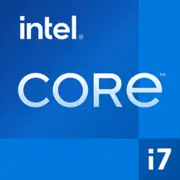Intel Core i7-4790K

Intel Core i7-4790K: A Haswell Legend in 2025
Architecture, Compatibility, and Relevance in Today's Conditions
Key Features: The Legacy of Haswell
The Intel Core i7-4790K processor, released in 2014, remains an iconic choice for enthusiasts. Its Haswell architecture (22 nm process technology) includes 4 cores and 8 threads thanks to Hyper-Threading. The base clock speed is 4.0 GHz, with Turbo Boost up to 4.4 GHz, which was groundbreaking for its time. The L3 cache size is 8 MB, and the integrated Intel HD 4600 graphics allowed for running less demanding games and handling multimedia without a discrete graphics card.
Key Features:
- High clock speed "out of the box."
- Unlocked multiplier for overclocking (up to 4.8–5.0 GHz with good cooling).
- Support for AVX2 and TSX-NI technologies, which accelerated workloads.
Performance in 2025:
According to Geekbench 6, the i7-4790K scores 1370 points in single-threaded tests and 4372 in multi-threaded tests. This performance is comparable to current budget CPUs, such as the Intel Core i3-12100 (single-threaded ~1800), but its multi-threaded performance falls short even compared to the Ryzen 5 5500 (~6000).
Compatible Motherboards: A Hunt for Rarities
The processor uses the LGA 1150 socket, which has long been discontinued. Current chipsets include:
- Z97 — for overclocking (e.g., ASUS Z97-A).
- H97 — basic functions without overclocking.
- B85 — a budget option for office tasks.
Selection Tips:
- On the secondary market (eBay, local platforms), motherboards range from $50 to $150.
- Check the condition of the VRM modules — they are critical for stability during overclocking.
- Look for models with USB 3.0 and SATA 6 Gb/s — this simplifies the use of modern drives.
A practical example: a user on the Overclockers.ru forum built a system on the MSI Z97 Gaming 5 with the i7-4790K overclocked to 4.7 GHz, achieving +15% performance in games.
Supported Memory: DDR3 and Its Limitations
The i7-4790K only works with DDR3 (up to 32 GB in dual-channel mode). The maximum frequency is 1600 MHz (without overclocking), but many motherboards support XMP profiles up to 2400 MHz.
Problems in 2025:
- DDR3 lags behind DDR4/DDR5 in speed and energy efficiency.
- Latencies (CL) are higher, impacting performance in latency-sensitive games and tasks.
Recommendation: Use memory with a frequency of 1866–2133 MHz (e.g., Kingston HyperX Fury) for an optimal balance of price and performance.
Power Supply: Minimalism with Headroom
With a TDP of 88 W (and up to 120 W when overclocked), the processor does not require a powerful PSU. However, considering the discrete graphics card:
- For systems with GTX 1660 Super or RX 6600, a 500 W PSU will suffice (e.g., Corsair CX550M, $65).
- For high-end GPUs (RTX 3080 and above), a PSU of at least 750 W is required, but such an upgrade is pointless due to the narrow PCIe 3.0 x16.
Important: Older PSUs can degrade. Choose models with an 80+ Bronze certification and overload protection.
Pros and Cons: Who Is It Suitable For in 2025?
Pros:
- Availability in the secondary market ($80–120 compared to $200 for a new i3-12100).
- Good performance in older games (e.g., The Witcher 3 on high settings).
- Ease of upgrading old PCs (if a compatible motherboard is available).
Cons:
- No support for PCIe 4.0, DDR4, or USB 3.2 Gen 2.
- Outdated instructions (no AVX-512, limited AI acceleration support).
- Higher power consumption compared to modern counterparts.
Use Cases: Where It Is Still Relevant?
1. Office and Multimedia: Watching 4K video, working with documents, and browsing with 10+ tabs.
2. Retro Gaming: Running games from the 2010s (Skyrim, GTA V) at medium settings (60 FPS with GTX 1060).
3. Server Tasks: Home NAS or media server thanks to low system costs.
Example: A Twitch streamer uses the i7-4790K with NVIDIA NVENC encoding for 720p streams without lag.
Comparison with Competitors: A Battle of Generations
- AMD FX-9590 (2013): 8 cores, but low IPC. In games, the i7-4790K is 30–40% faster.
- Intel Core i5-10400 (2020): 6 cores/12 threads, DDR4 support. Multi-threaded performance is 50% higher.
- Ryzen 5 5500 (2022): 6 cores/12 threads, PCIe 4.0. The best choice for budget builds ($120 new).
Conclusion: The i7-4790K falls behind modern budget CPUs but has a competitive edge in second-hand prices.
Practical Assembly Tips
1. Cooling: Even when overclocked, a tower cooler will suffice (Deepcool Gammaxx 400, $25).
2. Storage: Always use an SSD (SATA or NVMe via a PCIe adapter) — this reduces CPU load.
3. Graphics Card: Avoid models more expensive than the RTX 3060 — the processor will become a "bottleneck."
4. Check BIOS: Update the motherboard firmware for compatibility with large SSDs.
Final Verdict: Who Should Consider the i7-4790K in 2025?
This processor is suitable for:
- Enthusiasts building retro PCs.
- Owners of old systems on LGA 1150 wanting to extend the life of their hardware.
- Budget users who need enough power for basic tasks.
Why not consider it for new builds? Even inexpensive modern processors (e.g., Ryzen 5 5500) offer DDR4 support, PCIe 4.0, and better IPC. However, if you want to save money and are not chasing ultra-settings, the i7-4790K can still surprise you!
Prices are listed for new devices as of April 2025. The i7-4790K is no longer in production and is only available on the secondary market.
Basic
CPU Specifications
Memory Specifications
GPU Specifications
Benchmarks
Compared to Other CPU
Share in social media
Or Link To Us
<a href="https://cputronic.com/cpu/intel-core-i7-4790k" target="_blank">Intel Core i7-4790K</a>